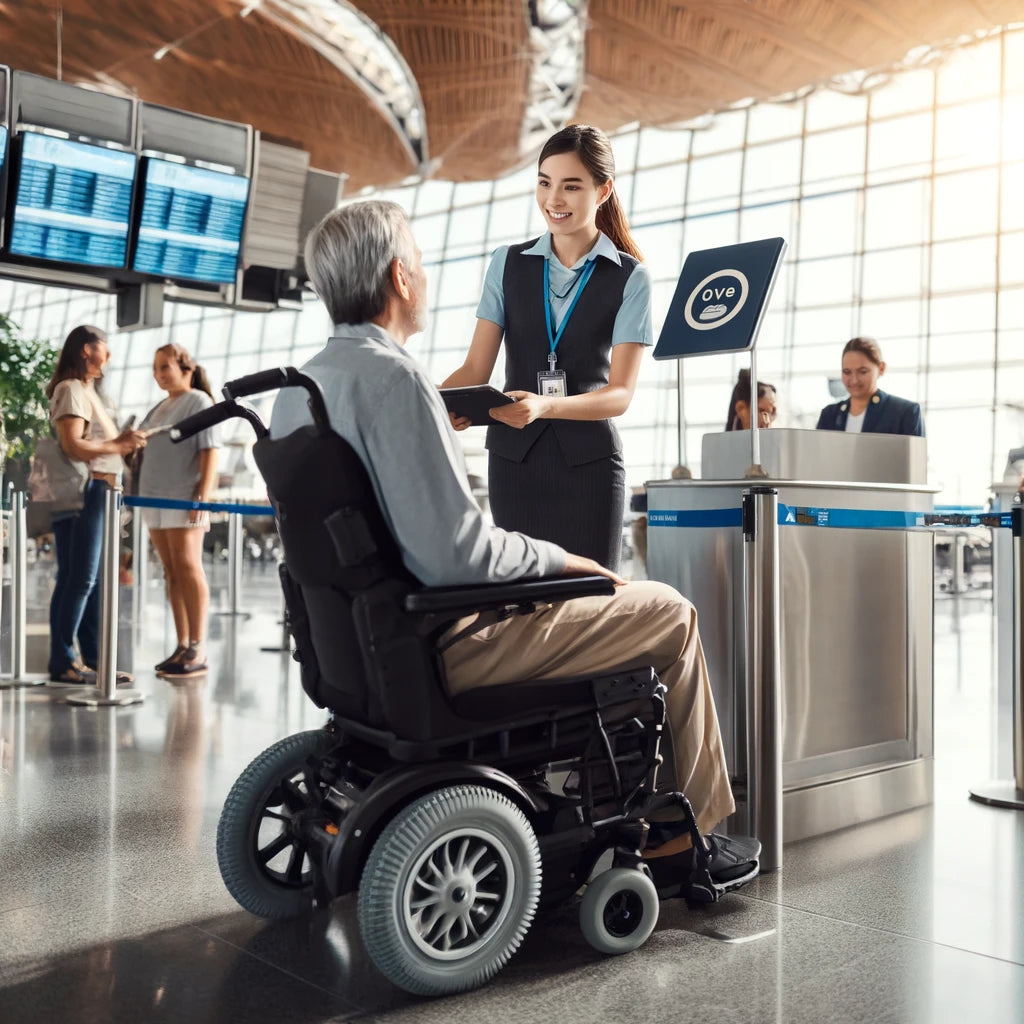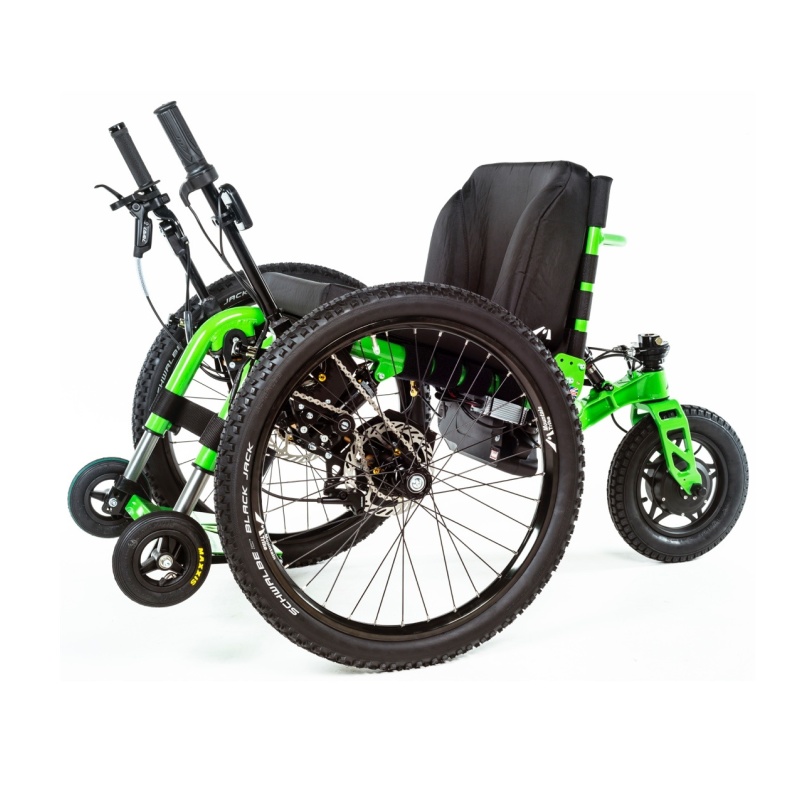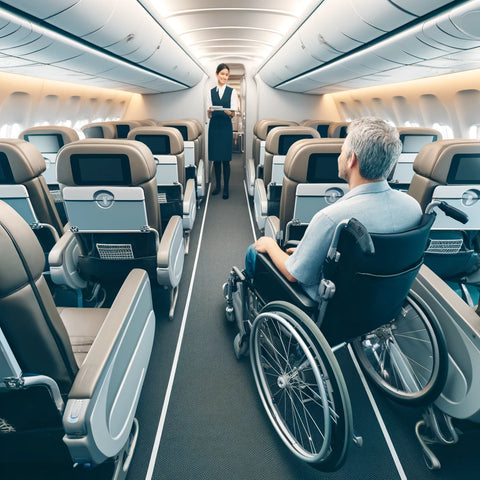
Taking a Power Wheelchair on a Flight - wheelchair battery guide
Share
Flying with an Electric Wheelchair Batteries
For wheelchair users, air travel can be a daunting experience, especially when it comes to getting your head around the regulations surrounding electric wheelchair batteries.
Whether you have a power wheelchair with lithium-ion batteries or a mobility scooter with sealed lead acid batteries, it’s crucial to understand the rules to ensure a smooth and stress-free journey.
In this comprehensive guide, we’ll cover everything you need to know about flying with electric wheelchair batteries in 2024.
How do I prepare my electric wheelchair batteries for air travel?
Proper preparation is key to avoiding issues when traveling with your electric wheelchair batteries:
-
Notify your airline at least 48 hours before your flight and provide details about your wheelchair model, battery type, and watt-hour rating. Request written confirmation of approval.
-
Ensure your batteries are properly packaged and protected from damage. See below for the different types of batteries and how they must be treated for airplane travel.
-
Bring your wheelchair manual and instructions for disassembly. Be prepared to explain how to disengage the drive system to ground staff.
-
Consider using a lightweight travel wheelchair if feasible to simplify the process. Familiarize yourself with how to engage and disengage freewheel mode.
-
Arrive at the airport early to allow extra time for assistance and potential issues. Bring any necessary tools, spare parts, and accessories.
-
Considered having printed copies of airline and UK/EU/FAA/IATA regulations on hand or ready to link to on your phone, as some staff may be unfamiliar with the rules. Politely educate them if needed.
-
Book assistance from airport mobility staff to help with your device and batteries. Clearly communicate your needs and have documentation ready.
-
Consider purchasing travel insurance that covers your mobility equipment in case of damage or loss.
What type of electric wheelchair batteries are allowed on planes?
Electric wheelchairs and mobility aids are typically powered by one of three types of batteries:
-
Lithium-ion batteries: These lightweight, high-energy density batteries are becoming increasingly popular in newer power wheelchairs.

The Mountrain Trike E-Trike is an Electric Assist All Terrain Chair with Lithium Batteries
Lithium-ion batteries are subject to specific airline and regional regulations.
Lithium-Ion Batteries
USA
- Removable batteries must not exceed 300 Wh, or 160 Wh each if there are two
- Batteries must be carried in the cabin and protected from damage
- Passengers can carry one spare battery ≤300 Wh or two spares ≤160 Wh each with airline approval.
- No limit on installed battery Wh rating, but device must be protected from accidental activation
UK and EU
- Removable batteries must not exceed 100 Wh, unless approved by the airline
- Batteries must be carried in the cabin and protected from damage
- Passengers can carry up to 20 spare batteries ≤100 Wh each
- Batteries between 101-160 Wh are permitted with airline approval, limited to two spares per person
Full UK Regulations available here
Canada
- Removable batteries must not exceed 100 Wh
- Batteries must be carried in the cabin and protected from damage
- Passengers can carry a “reasonable” number of spare batteries ≤100 Wh for personal use
- Batteries between 101-160 Wh are permitted with airline approval, limited to two spares per person
For more info about the lithium battery regulations in Canada click here
Regardless of location, lithium batteries pose potential hazards due to their high energy density and flammable electrolyte. General safety practices include
- Preventing physical damage to batteries
- Protecting batteries from temperature extremes
- Using compatible chargers to avoid overcharging
- Discontinuing use of damaged batteries
- Storing batteries in a cool, dry place away from combustible materials
- Having an emergency response plan for battery incidents
Sealed Dry Cell lead acid, AGM, and gel cell batteries:
Many power wheelchairs use sealed lead acid (SLA), absorbed glass mat (AGM), gel cell, or dry cell batteries, which generally do not need to be removed during air travel.
These battery types are considered non-spillable and are safer to transport than traditional wet cell batteries used on older power wheelchairs.
However, it’s crucial to check with your airline for specific requirements, as policies can vary.
Some airlines may require the battery terminals to be disconnected and taped or covered with electrical tape to prevent short circuits.
This has caused many problems for wheelchair users, as the tape can be difficult to remove upon arrival, delaying you getting back into your wheelchair.
This is the last thing you want after a long flight often with no toilet access!
Real Life experiences of the wheelchair taping issue!
“I’ve had my chair “taped up” a few times by airport staff. It’s annoying because they often use a ton of tape and it can be difficult to remove when you arrive at your destination.”
“I bought a cheap set of battery terminal plugs. They’re easy to put on and take off, and the airport staff from goingc mad with the tape! We never have any issues at the other end now.”
Battery Isolation Switches and Quick-Release Boxes

To address this issue, some wheelchair users opt for a battery isolation switch or a quick-release battery box. These devices allow the battery to be easily disconnected without the need for tape or covers. One popular product is the Power Wheelchair Battery Isolator for Air Travel, available from Disability Health Shop.
This device uses an Anderson Connector end cap to immobilize electrical mobility equipment, making it ideal for air travel. The Anderson Connector is an economical and practical way to ensure your power chair or mobility scooter is immobilized while in-flight. It’s available in four different sizes to fit most chairs - simply check your required plug size before purchasing.
Spillable wet cell batteries:
These are less common but may be found in some older mobility devices. Spillable batteries must be removed and packaged separately in special battery boxes
Battery Removal and Packaging
If the battery does need to be removed, ensure it is properly packaged in a sturdy, leak-proof battery case with the terminals covered. Label the case with the battery type, voltage, and watt-hour rating, and include any necessary handling instructions.
It’s important to note that even if your battery is allowed to remain connected, you may still be required to protect the terminals and prevent inadvertent activation during transport. Consult with your airline and review their specific guidelines to ensure compliance and avoid any last-minute surprises at the airport.
Tips from Wheelchair Users
If you are a facebook user I recommend joing a group that discusses lots of issues around disability and travel called " The World is Accessible". It is a closed group but it is easy to join.
Here are some tips from contributors about air travel with a wheelchair with batteries:
- Assistance from Airport Staff
-
Many airports have PRM (Persons with Reduced Mobility) assistance staff who can help remove and carry batteries
-
Emphasize the importance of communicating needs to airline staff ahead of time
-
Mention that flight crew have helped carry batteries onboard in some cases
- Battery Storage Bags
-
Some airlines may require fireproof or universal battery bags for storage
-
Recommend readers purchase appropriate battery bags on Amazon as an inexpensive safety precaution
-
Suggest using a duffle bag or custom canvas bag to keep all wheelchair parts together
- Airline-Specific Experiences
-
Positive experiences with specific airlines like Delta and Southwest
-
Some airlines like Delta may not require battery removal for certain chair types
-
Encourage readers to check airline apps and websites for specific policies
- Importance of Honesty
-
Stress that readers should never lie about having lithium batteries as it could result in serious consequences
-
Being upfront allows airlines to best assist passengers and ensure safety
- Battery Differences
-
Clarify the differences between lithium-ion, sealed lead acid, and dry gel batteries
-
Note that most power wheelchairs use dry gel batteries that don’t require removal
-
Lithium-ion is more common in lightweight folding chairs and scooters
Key Takeaways
- Sealed lead acid, AGM, gel cell, and dry cell batteries are generally easier to travel with than spillable batteries
- Research your airline’s policies regarding wheelchair batteries
- Consider using battery isolation switches like the Power Wheelchair Battery Isolator for Air Travel or quick-release boxes to streamline the process
- Proper packaging, labeling, and communication with the airline staff are key to ensuring a smooth and stress-free travel experience
By understanding the regulations, preparing properly, and communicating clearly, you can ensure a smooth journey when flying with sealed lead acid, AGM, gel cell, and dry cell wheelchair batteries.
To Sum up: Thousands of wheelchairs with batteries travel on planes every day!
Traveling with an electric wheelchair and lithium batteries requires some extra planning, but it’s entirely possible to have a smooth, enjoyable trip. By understanding the regulations, preparing your device and batteries properly, and communicating your needs clearly to the airline and airport staff, you can confidently navigate air travel with your mobility aid. Remember, your freedom to travel should never be limited by your wheelchair - with the right knowledge and preparation, the sky’s the limit!
Although these regulations seem may seem worrying it’s important not to be put off taking your power chair on holiday. You need it and they will make accommodations for you. Have a good trip!
One day we hope all planes will allow wheelchair users to remain in their chairs during the flight - join the campaign here "Rights on Flights"

About the Author: Duncan Edwards
Duncan Edwards is an authority on travelling with a powered wheelchair, having taken dozens of flights with his wife and her battery-operated wheelchair.
He has pioneered and popularised the Wheelchair Battery Isolator Product, a crucial tool that enhances travel safety and convenience.
His extensive experience and innovative solutions make him a trusted voice in the wheelchair travel community.
